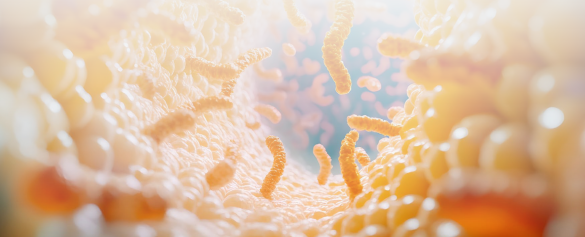
Mycotoxins
The intestinal barrier is one of the body’s first lines of defense against pathogens and external contaminants.
In this regard, numerous studies focus on the impact of exposure of the intestinal barrier to toxins, including mycotoxins – secondary metabolites produced by mycotoxigenic fungi that frequently present in feed ingredients.
Given the wide occurrence of mycotoxins in raw materials for animal feed, usually with several being found simultaneously, the digestive system is exposed to higher concentrations than other organs, and it is essential to know the mechanisms involved in the alterations of the intestinal barrier induced by these toxins.
THE DELICATE BALANCE OF THE INTESTINAL BARRIER
The intestinal barrier is essential for gastrointestinal health, being a multifaceted structure composed of different levels of protection.
These levels include physical, chemical, immune and microbial barriers that work together to maintain intestinal homeostasis and protect the body from harmful external agents.
PHYSICAL BARRIER
The intestinal epithelium plays a fundamental role in the formation of the physical barrier, being formed by enterocytes, goblet cells, Paneth cells and enteroendocrine cells distributed in a single layer that covers the surface of the intestine.
Tight junctions are particularly important in the regulation of intestinal paracellular permeability, which contributes significantly to barrier integrity.
CHEMICAL BARRIER
Represented mainly by the mucus layer that lines the surface of the intestine.
This mucus layer is composed mainly of mucins and antimicrobial proteins produced by goblet cells and Paneth cells. Its main function is:
IMMUNITY BARRIER
It plays a crucial role in the protection of the intestine, being composed of immune cells located in the lamina propria, such as intraepithelial lymphocytes, Paneth cells and IgA-secreting plasma cells, as well as immune mediators such as IgA and cytokines.

MICROBIAL BARRIER
Represented by the intestinal microbiota, composed of a wide variety of microorganisms, playing a crucial role in intestinal health through their protective, metabolic and structural functions.

LOWER INTESTINE, UNDER SIEGE FROM MYCOTOXINS
Several in vitro and in vivo studies have been carried out showing the detrimental effects of intestinal barrier exposure to mycotoxins, especially those most frequently found (aflatoxins -AF-, zearalenone -ZEN-, ochratoxin A -OTA-, fumonisins -FB-, deoxynivalenol -DONand T-2 toxin), alone or in combination, in feed and food raw materials.
DESTROYING THE CHEMICAL BARRIER
In addition to affecting the physical barrier, mycotoxins also alter the intestinal chemical barrier, having been shown to modify the composition of intestinal mucin, thus altering its function.
Regarding the production of antimicrobial peptides, it has been shown that mycotoxins increase their production, with an increase in the expression of porcine defensins 1 and 2 having been observed.
In an in vitro study published in 2015, it was reported that Porcine beta-defensin 2 increased the expression of mucin mRNA in Caco-2 cells, deducing that, when the intestinal tract is damaged by mycotoxins, the secretion of antimicrobial peptides stimulated mucin production to improve the function of chemical barrier of the intestinal mucosa.
In this regard, numerous studies have pointed to the addition of antimicrobial peptides to feed as a strategy to antagonize mycotoxin toxicity.
Regarding the immune barrier, it has been observed that mycotoxins are able to stimulate the secretion of proinflammatory compounds, increasing intestinal permeability and facilitating the passage of toxins and pathogens into the bloodstream.

In conclusion, mycotoxins represent a silent threat to intestinal integrity, interfering with multiple aspects of the gastrointestinal barrier and unbalancing its optimal functioning.
The intestinal barrier, composed of physical, chemical, immune and microbial barriers, is essential for maintaining intestinal homeostasis and protecting the body from
harmful agents.
From decreasing transepithelial resistance to altering the composition of the intestinal microbiota, mycotoxins exert their influence in a wide and varied manner in the gut.
Consequently, it is critical to understand the precise mechanisms by which mycotoxins affect intestinal integrity and how these alterations contribute to disease predisposition and economic losses in animal production, and it is essential to implement prevention and mitigation strategies to reduce exposure to these toxins and protect animal health and welfare.
Subscribe now to the poultry technical magazine
AUTHORS

Layer Longevity Starts at Rearing
H&N Technical Team
The Strategy for a Proper Infectious Bronchitis Control
Ceva Technical Team
Elevate Hatchery Performance with Petersime’s New Data-Driven Incubation Support Service
Petersime Technical Team
Maize and Soybean Meal Demand and Supply Situation in Indian Poultry Industry
Ricky Thaper
Production of Formed Injected Smoked Chicken Ham
Leonardo Ortiz Escoto
Antimicrobial Resistance in the Poultry Food Chain and Novel Strategies of Bacterial Control
Edgar O. Oviedo-Rondón
GREG TYLER INTERVIEW
Greg Tyler
Insights from the Inaugural US-RSPE Framework Report
Elena Myhre
Newcastle Disease: Knowing the Virus Better to Make the Best Control Decisions. Part II
Eliana Icochea D’Arrigo
Avian Pathogenic E. coli (APEC): Serotypes and Virulence
Cecilia Rosario Cortés
The Importance of Staff Training on Animal Welfare Issues in Poultry Industry
M. Verónica Jiménez Grez
Rodent Control is a Key Factor in Poultry Biosecurity and Sustainability
Edgar O. Oviedo-Rondón